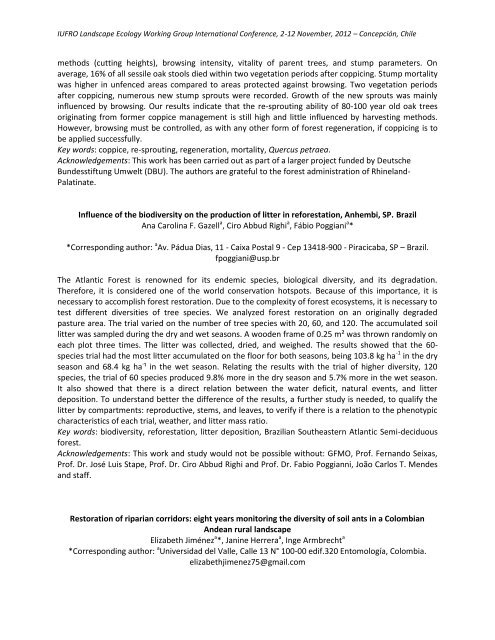BOOK OF ABSTRACTS - iufro landscape ecology conference
BOOK OF ABSTRACTS - iufro landscape ecology conference
BOOK OF ABSTRACTS - iufro landscape ecology conference
You also want an ePaper? Increase the reach of your titles
YUMPU automatically turns print PDFs into web optimized ePapers that Google loves.
IUFRO Landscape Ecology Working Group International Conference, 2-12 November, 2012 – Concepción, Chilemethods (cutting heights), browsing intensity, vitality of parent trees, and stump parameters. Onaverage, 16% of all sessile oak stools died within two vegetation periods after coppicing. Stump mortalitywas higher in unfenced areas compared to areas protected against browsing. Two vegetation periodsafter coppicing, numerous new stump sprouts were recorded. Growth of the new sprouts was mainlyinfluenced by browsing. Our results indicate that the re-sprouting ability of 80-100 year old oak treesoriginating from former coppice management is still high and little influenced by harvesting methods.However, browsing must be controlled, as with any other form of forest regeneration, if coppicing is tobe applied successfully.Key words: coppice, re-sprouting, regeneration, mortality, Quercus petraea.Acknowledgements: This work has been carried out as part of a larger project funded by DeutscheBundesstiftung Umwelt (DBU). The authors are grateful to the forest administration of Rhineland-Palatinate.Influence of the biodiversity on the production of litter in reforestation, Anhembi, SP. BrazilAna Carolina F. Gazell a , Ciro Abbud Righi a , Fábio Poggiani a **Corresponding author: a Av. Pádua Dias, 11 - Caixa Postal 9 - Cep 13418-900 - Piracicaba, SP – Brazil.fpoggiani@usp.brThe Atlantic Forest is renowned for its endemic species, biological diversity, and its degradation.Therefore, it is considered one of the world conservation hotspots. Because of this importance, it isnecessary to accomplish forest restoration. Due to the complexity of forest ecosystems, it is necessary totest different diversities of tree species. We analyzed forest restoration on an originally degradedpasture area. The trial varied on the number of tree species with 20, 60, and 120. The accumulated soillitter was sampled during the dry and wet seasons. A wooden frame of 0.25 m² was thrown randomly oneach plot three times. The litter was collected, dried, and weighed. The results showed that the 60-species trial had the most litter accumulated on the floor for both seasons, being 103.8 kg ha -1 in the dryseason and 68.4 kg ha - ¹ in the wet season. Relating the results with the trial of higher diversity, 120species, the trial of 60 species produced 9.8% more in the dry season and 5.7% more in the wet season.It also showed that there is a direct relation between the water deficit, natural events, and litterdeposition. To understand better the difference of the results, a further study is needed, to qualify thelitter by compartments: reproductive, stems, and leaves, to verify if there is a relation to the phenotypiccharacteristics of each trial, weather, and litter mass ratio.Key words: biodiversity, reforestation, litter deposition, Brazilian Southeastern Atlantic Semi-deciduousforest.Acknowledgements: This work and study would not be possible without: GFMO, Prof. Fernando Seixas,Prof. Dr. José Luis Stape, Prof. Dr. Ciro Abbud Righi and Prof. Dr. Fabio Poggianni, João Carlos T. Mendesand staff.Restoration of riparian corridors: eight years monitoring the diversity of soil ants in a ColombianAndean rural <strong>landscape</strong>Elizabeth Jiménez a *, Janine Herrera a , Inge Armbrecht a*Corresponding author: a Universidad del Valle, Calle 13 N° 100-00 edif.320 Entomología, Colombia.elizabethjimenez75@gmail.com


